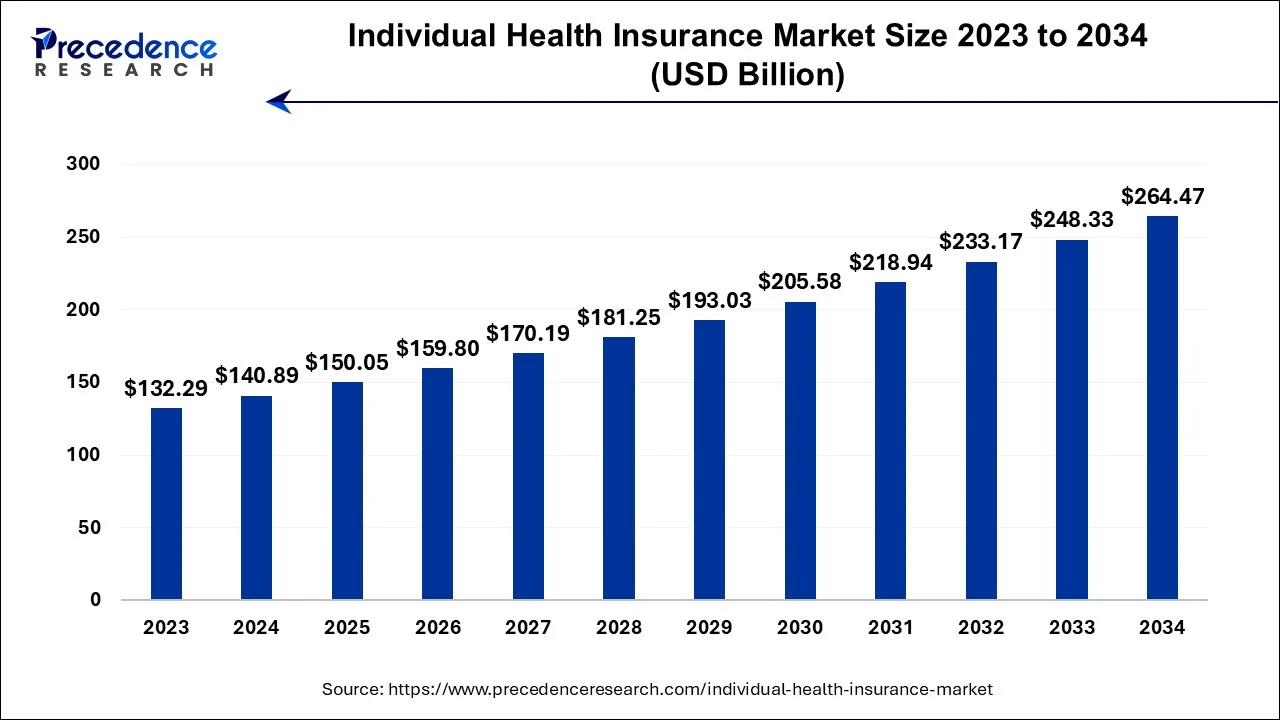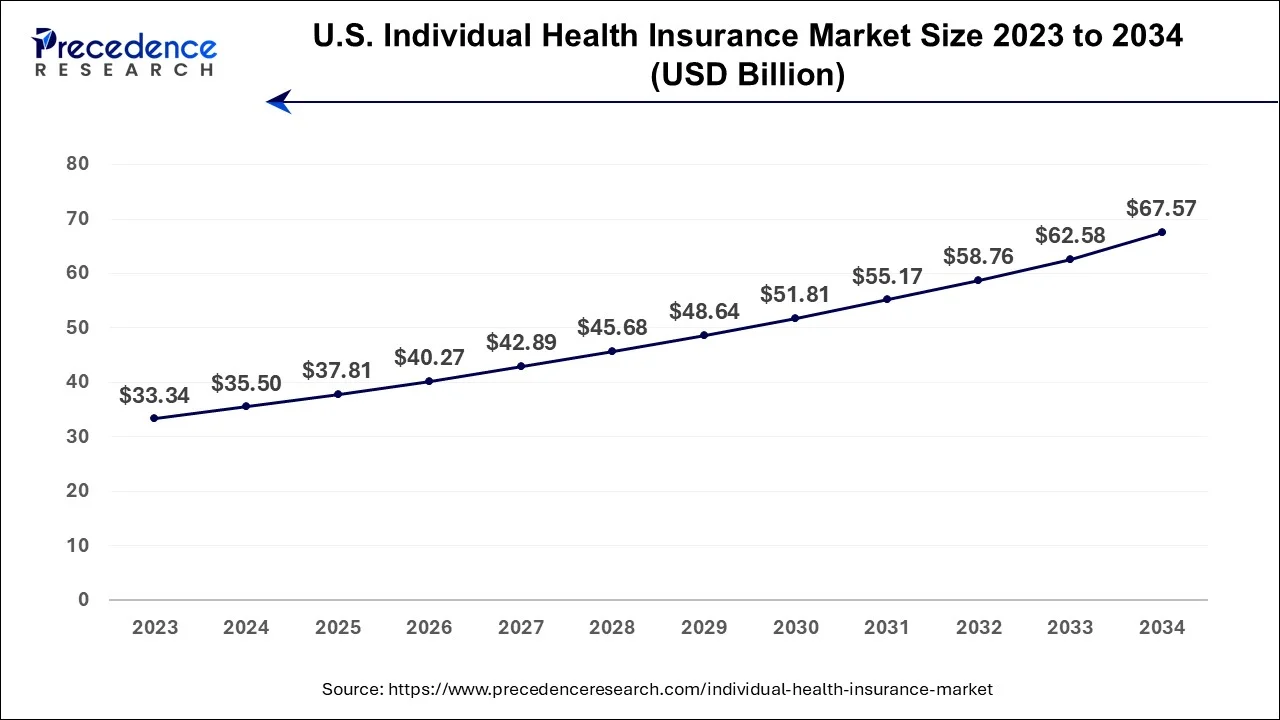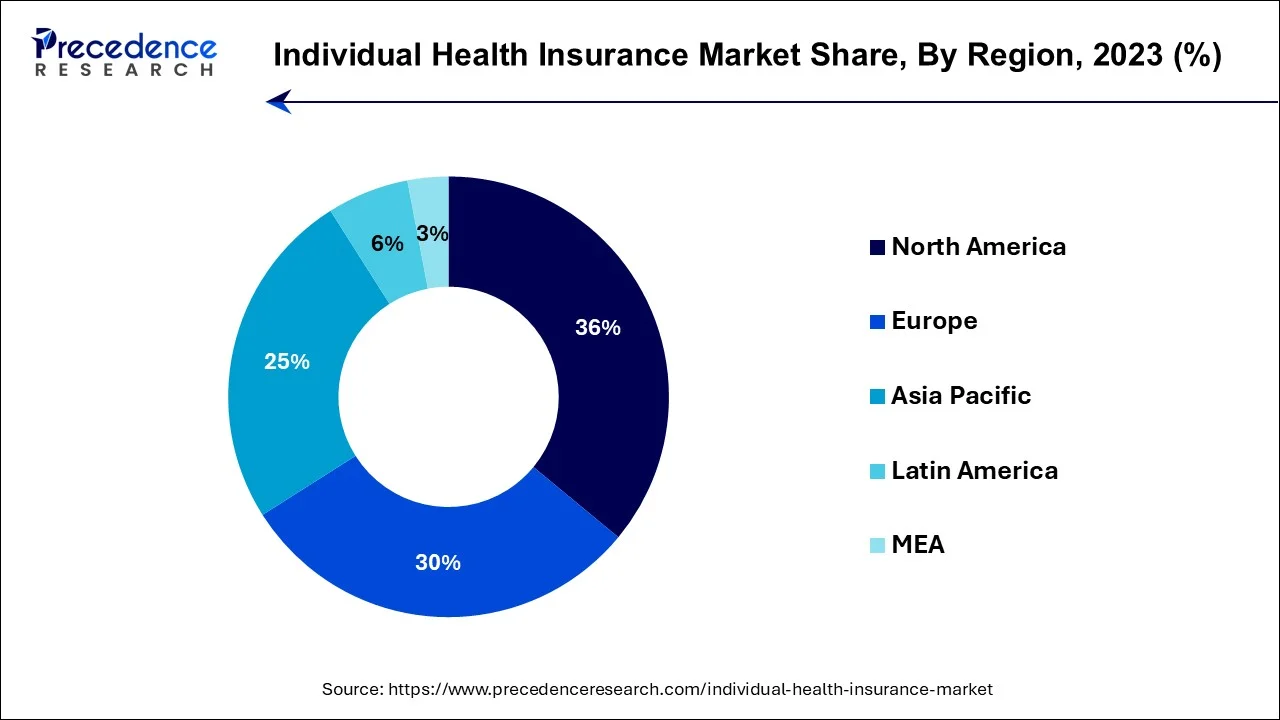Individual Health Insurance Market Size and Forecast 2024 to 2034
The global individual health insurance market size accounted for USD 140.89 billion in 2024 and is anticipated to reach around USD 264.47 billion by 2034, expanding at a CAGR of 6.50% between 2024 and 2034.

Individual Health Insurance Market Key Takeaways
- North America contributed more than 36% of the revenue share in 2023.
- Asia Pacific is estimated to expand the fastest CAGR between 2024 and 2034.
- By Type, the health maintenance organization (HMO) segment has held the largest market share of 44% in 2023.
- By Type, the preferred provider Organization (PPO) segment is anticipated to grow at a remarkable CAGR of 8.5% between 2024 and 2034.
- By Application, the individual coverage segment generated over 39% of revenue share in 2023.
- By Application, the student health insurance segment is expected to expand at the fastest CAGR over the projected period.
- By Policy, the basic health policies segment had the largest market share of 48% in 2023.
- By Policy, the comprehensive health policies segment is expected to expand at the fastest CAGR over the projected period.
U.S. Individual Health Insurance Market Size and Growth 2024 to 2034
The U.S. individual health insurance market size ie estimated at USD 35.50 billion in 2024 and is expected to be worth around USD 67.57 billion by 2034, registering a CAGR of 6.65% between 2024 and 2034.

North America has held the largest revenue share 36% in 2023. In North America, the individual health insurance market has witnessed a growing demand for innovative insurance solutions. Telehealth adoption has surged, making healthcare more accessible and driving insurers to provide digital health integration. Additionally, the pandemic has underscored the importance of comprehensive coverage, with individuals seeking plans that include COVID-19-related expenses. Regulatory changes have facilitated access to coverage during economic uncertainties. The market in North America continues to evolve with a focus on technology-driven services and adaptable insurance products.

Asia-Pacific is estimated to observe the fastest expansion. In the Asia-Pacific region, individual health insurance has experienced increasing popularity due to rising healthcare costs and an expanding middle class. There's a growing trend toward customizing policies to suit specific healthcare needs. Moreover, digital health solutions, including mobile apps and telemedicine, have gained prominence. As the region becomes more urbanized and health-conscious, insurers are tapping into this market by offering comprehensive coverage and wellness programs. Regulatory changes and a shift toward preventive healthcare measures are shaping the Asia-Pacific Individual Health Insurance market.
In Europe, the individual health insurance market reflects a diverse landscape with variations in regulatory frameworks across countries. The market emphasizes comprehensive coverage, including pandemic-related expenses. Digital health integration and telemedicine services have gained traction, enhancing healthcare accessibility. The region's commitment to universal healthcare systems influences individual insurance preferences, with many opting for supplementary coverage. Europe's Individual Health Insurance market exhibits adaptability in response to shifting healthcare needs and regulatory nuances.
Market Overview
Individualhealth insuranceis a personal insurance policy that people buy to safeguard themselves against medical costs. Unlike group plans provided by employers, individuals directly purchase this coverage. It usually includes doctor visits, hospital stays, prescription medications, and preventive care.
Policyholders pay monthly premiums and may face deductibles, copayments, and coinsurance. It's crucial for self-employed individuals or those ineligible for employer-based plans, to offer financial protection and healthcare access as needed. It usually includes doctor visits, hospital stays, prescription medications, and preventive care. Policyholders pay monthly premiums and may face deductibles, copayments, and coinsurance.
Individual Health Insurance Market Growth Factors
- The Individual health insurance market offers personalized medical coverage for individuals, safeguarding them from healthcare expenses.
- It is distinct from group insurance plans and is directly purchased by policyholders.
- Coverage typically includes doctor visits, hospital stays, prescription drugs, and preventive care.
- Policyholders pay monthly premiums and may encounter deductibles, copayments, and coinsurance.
- Growth drivers include a rising number of self-employed individuals, increasing healthcare costs, and demand for personalized healthcare.
- Industry trends include the expansion of coverage to include dental, vision, and maternity benefits for more comprehensive healthcare solutions.
- Challenges in the industry involve regulatory changes, premium affordability, and market competition.
- Business opportunities lie in innovative product development, such as incorporating digital health services and wellness programs.
- Adapting to changing consumer preferences and regulatory complexities is crucial for individual health insurance providers to meet the evolving demands of policyholders.
- Market Expansion: The individual health insurance market has witnessed expansion as more individuals seek coverage due to the changing landscape of healthcare and the need for protection against medical expenses.
- Technological Advancements: With the integration of technology, there is a growing opportunity for insurers to enhance customer experiences through digital platforms, telehealth services, and data-driven insights, thereby improving service efficiency and customer satisfaction.
Market Scope
| Report Coverage | Details |
| Growth Rate from 2024 to 2034 | CAGR of 6.50% |
| Market Size in 2024 | USD 140.89 Billion |
| Market Size by 2034 | USD 150.05 Billion |
| Largest Market | North America |
| Base Year | 2023 |
| Forecast Period | 2024 to 2034 |
| Segments Covered | Type, Application, Application, and Region |
| Regions Covered | North America, Europe, Asia-Pacific, Latin America, and Middle East & Africa |
Market Dynamics
Driver
Increased self-employment and consumer awareness
Increased self-employment has significantly contributed to the surge in demand for individual health insurance. As the gig economy and freelance work continue to grow, more people find themselves without employer-sponsored health plans. In response, they turn to individual health insurance to secure their healthcare needs. This trend is further amplified by the COVID-19 pandemic, which prompted a wave of job losses and spurred many individuals to pursue self-employment or freelance work. This shift in employment dynamics underscores the crucial role of individual health insurance in ensuring access to healthcare services and protecting against unexpected medical expenses.
Consumer awareness is another potent driver. Individuals are becoming increasingly conscious of the financial vulnerabilities associated with unforeseen healthcare costs. The COVID-19 pandemic heightened this awareness, as it underscored the importance of having reliable health insurance coverage. This awareness prompts more individuals to actively seek out and purchase individual health insurance policies to safeguard their financial well-being and ensure access to quality healthcare. The synergy between increased self-employment and rising consumer awareness fuels the growth of the individual health insurance market as more people recognize the necessity of having personal coverage in today's dynamic employment landscape.
Restraint
Pre-existing conditions and limited coverage options
Pre-existing conditions and limited coverage options present significant restraints to the market demand for individual health insurance. These conditions refer to health issues or ailments that individuals have before seeking insurance. Many insurance providers may either deny coverage or impose high premiums on individuals with pre-existing conditions, discouraging potential policyholders and limiting their access to essential healthcare protection. This exclusion can be particularly burdensome for individuals who require ongoing medical care, as it may leave them with limited or unaffordable insurance options, hindering market growth.
Additionally, the limited coverage options available in the individual health insurance market can deter potential buyers. Some plans may lack comprehensive coverage, leaving individuals with gaps in their healthcare protection. This limited scope may not meet the diverse and evolving healthcare needs of policyholders, further reducing the appeal of individual health insurance. As a result, addressing these challenges, such as finding ways to provide affordable coverage for those with pre-existing conditions and expanding comprehensive coverage options, is essential to foster market demand and ensure individuals have access to vital healthcare protection.
Opportunity
Digital health integration and wellness programs
The integration of digital health solutions and wellness programs is revolutionizing the individual health insurance market, significantly boosting market demand. The integration of digital health, such as telehealth services, mobile health apps, and wearable devices, offers policyholders convenient access to healthcare resources. This improves the overall customer experience and appeals to tech-savvy individuals, motivating them to invest in health insurance that aligns with their preference for accessible and technology-driven healthcare solutions.
Furthermore, wellness programs integrated into insurance policies incentivize healthier lifestyles and preventive care. Insurers frequently provide incentives such as discounts, rewards, or lower premiums to policyholders who actively participate in wellness activities, such as exercise routines, dietary plans, or regular health check-ups. This not only promotes a healthier and proactive approach to healthcare but also attracts more individuals to enroll in health insurance, lured by the potential financial advantages. As a result, the integration of digital health tools and wellness programs transforms individual health insurance from a reactive safety net into a proactive, holistic healthcare solution, thus surging market demand by appealing to a broader consumer base.
Impacts of COVID-19
- The pandemic heightened awareness about the need for health insurance, as individuals sought financial protection against unforeseen medical expenses, hospitalization, and treatment related to COVID-19.
- The shift towards telehealth services and digital healthcare solutions accelerated, making remote consultations and healthcare monitoring more accessible, prompting insurance providers to adapt and expand their digital offerings.
- Individuals began looking for more comprehensive health insurance policies, including coverage for testing, treatment, and vaccines related to COVID-19, as well as other healthcare needs.
- Job losses and changes in employment status led to a surge in demand for individual health insurance, particularly for those who lost employer-sponsored coverage.
- Governments and insurance regulators introduced temporary changes to ensure individuals had access to affordable coverage during the pandemic, including special enrollment periods and premium subsidies.
Type Insights
According to the type, the health maintenance organization (HMO) segment has held 44% revenue share in 2023. A health maintenance organization (HMO) is a type of health insurance plan that emphasizes cost-effective healthcare delivery. HMO policyholders are required to select a primary care physician (PCP) and typically need referrals from the PCP to access specialist care. These plans often have lower premiums and out-of-pocket costs, making them attractive to budget-conscious individuals. A trend in the individual health insurance market concerning HMOs is their continued popularity due to affordability and controlled costs. However, some individuals are seeking greater flexibility, which has led to the emergence of more versatile plan options.
The Exclusive Provider Organization (EPO) segment is anticipated to expand at a significant CAGR of 8.5% during the projected period. An exclusive provider organization (EPO) is a type of individual health insurance plan that offers coverage exclusively within a network of healthcare providers. EPO policies do not require policyholders to choose a primary care physician or obtain referrals for specialist care. These plans provide flexibility in terms of where and how individuals receive healthcare while still offering cost savings when using in-network providers. In the individual health insurance market, EPOs have gained traction as they strike a balance between affordability and choice, allowing policyholders to access a wide range of healthcare services within the network without a primary care gatekeeper. However, consumers must remain mindful of staying within the defined network to maximize cost benefits.
Application Insights
Based on application, the individual coverage segment held the largest market share of 39% in 2023.Individual coverage in the individual health insurance market refers to policies designed for individuals and often their families. It offers personal medical protection, including doctor visits, hospital stays, prescription drugs, and preventive care. A trend in this segment involves the customization of coverage, allowing individuals to select plans that suit their unique healthcare needs and budgets. It also includes increased integration of digital health services to enhance the customer experience and improve accessibility to healthcare resources.
On the other hand, the student health insurance segment is projected to grow at the fastest rate over the projected period. Student health insurance focuses on providing coverage to students, often those pursuing higher education. These policies cater to the specific healthcare needs of students, offering coverage for illnesses, accidents, and preventive care. A trend in student health insurance is the inclusion of mental health services, recognizing the importance of addressing students' mental well-being. Additionally, universities and educational institutions increasingly offer these plans as part of their student services, expanding the reach of student health insurance in the market.
Policy Insights
In 2023, the basic health policies segment had the highest market share of 48% on the basis of the policy. Basic health policies in the individual health insurance market provide essential coverage, typically including hospital stays, doctor visits, and necessary medical treatments. These policies are suitable for individuals seeking fundamental protection at a lower cost. A trend in this category is the inclusion of telehealth services and prescription drug coverage to meet evolving healthcare needs. Basic policies are also experiencing greater consumer interest, especially among younger, healthier individuals looking for affordable options.
The comprehensive health policies segment is anticipated to expand fastest over the projected period. Comprehensive health policies, on the other hand, offer more extensive coverage, including additional services like dental, vision, and maternity benefits. These policies cater to individuals who want a broader array of healthcare services and are willing to pay higher premiums for comprehensive protection. A trend in comprehensive policies is the focus on preventative care and wellness programs, aligning with the growing importance of proactive health management in the insurance industry. Overall, the individual health insurance market continues to offer a range of policy options to accommodate diverse healthcare needs and preferences.
Individual Health Insurance Market Companies
- UnitedHealth Group
- Anthem, Inc.
- Aetna
- Humana Inc.
- Cigna Corporation
- Kaiser Permanente
- Blue Cross Blue Shield Association
- WellCare Health Plans
- Centene Corporation
- Molina Healthcare
- Health Care Service Corporation (HCSC)
- Highmark Inc.
- Independence Blue Cross
- Regence BlueCross BlueShield
- Ambetter
Recent Developments
- In 2023, WTW unveiled Neuron, a high-tech digital insurance platform. Neuron enhances connectivity between underwriters and brokers, streamlining operations through digitization, automation, and data optimization, thereby expediting processes and reducing costs in the insurance industry.
- In 2023, Adobe collaborated with Hong Kong's leading digital life insurer, Blue Insurance Limited, to elevate digital customer experiences in the insurance industry. Blue will leverage Adobe's Experience Cloud, including RT-CDP and CJA, to foster engaging and personalized interactions with a holistic view of customers.
- In 2023, Microsoft and Majesco formed a strategic alliance to enable insurers to undergo digital transformation. Using Microsoft Cloud and Analytics, this partnership provides a secure, scalable, and intelligent cloud ecosystem for customers.
- In 2023, DXC Technology partnered with Polo Managing Agency (PMA) in the Lloyd's insurance market. PMA will adopt DXC Assure Commercial and Specialty, leveraging DXC's AI and ML-powered insurance platform for enhanced capabilities and efficiency.
Segments Covered in the Report
By Type
- Health Maintenance Organization (HMO)
- Preferred Provider Organization (PPO)
- Exclusive Provider Organization (EPO)
- High Deductible Health Plan (HDHP)
- Others
By Application
- Individual Coverage
- Family Coverage
- Senior Coverage
- Student Health Insurance
- Others
By Policy
- Basic Health Policies
- Comprehensive Health Policies
- Short-term Health Policies
- Others
By Geography
- North America
- Europe
- Asia-Pacific
- Latin America
- Middle East and Africa
For inquiries regarding discounts, bulk purchases, or customization requests, please contact us at sales@precedenceresearch.com
Frequently Asked Questions
Ask For Sample
No cookie-cutter, only authentic analysis – take the 1st step to become a Precedence Research client
 sales@precedenceresearch.com
sales@precedenceresearch.com
 +1 804-441-9344
+1 804-441-9344